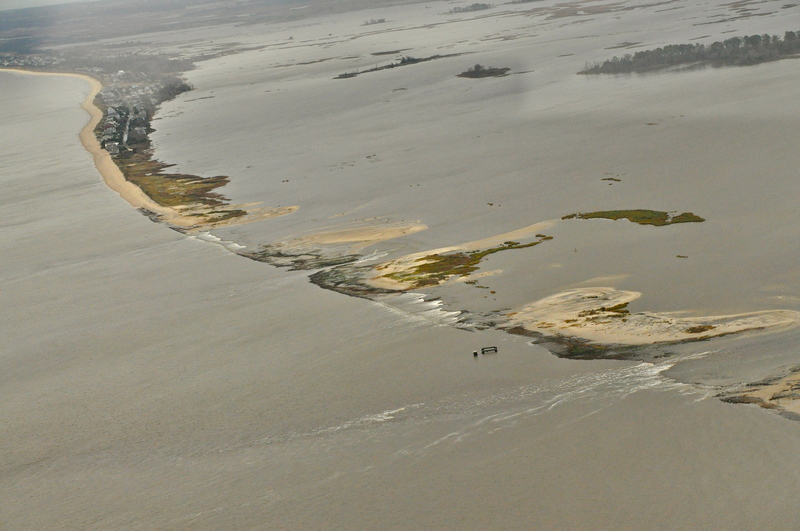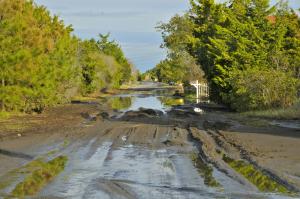Although the wheels of change were in place earlier, storms in 2008 and 2009 started drastic ecological changes in Prime Hook National Wildlife Refuge. In a series of domino-like events, storms breached the protective Fowler Beach dunes, and tidal saltwater from Delaware Bay flowed in, decimating refuge marshes, flooding nearby communities and putting access roads at risk.
In a very short time, the once-thriving freshwater Unit 2 marsh impoundment was unrecognizable; submerged by saltwater. Federal officials say up to 4,000 acres of marsh in the 10,000-acre refuge has been destroyed by saltwater intrusion.
Permitting issues, a lawsuit and a delayed refuge comprehensive conservation plan played into the natural events. It took five years for federal officials to come up with a plan that calls for rebuilding the beach and dunes and restoring Unit 2 and Unit 3 to saltwater marsh systems. Now, federal officials have nearly $40 million at their disposal to restore the refuge.
The following dates offer a snapshot of critical events over the past six years at the refuge.
2008: A year of storms
May 12-13: Storm opens large breach in the duneline protecting Prime Hook refuge marshes.
2009: The breaches widen
Feb. 5: DNREC denies permits for Primehook Beach resident to scrape sand to rebuild dunes.
2010: Talk about sea-level rise
March: Scientists say by 2100 sea-level rise will flood at least 50 percent of Prime Hook's marshes.
May: Federal officials block a DNREC plan to repair the breaches.
2011: Dune repair proceeds but fails
May 9: U.S. Fish & Wildlife Service recognizes rapid changes in the refuge and authorizes a more complex environmental assessment is required for the comprehensive conservation plan.
Aug. 17: Court action holds up a plan to repair Fowler Beach dunes until September.
Aug. 27: Hurricane Irene passes offshore and widens the breaches; flooding hits bay communities and forces closure of Prime Hook Road for six days. DelDOT crews are called in to rebuild sections of the road.
Sept. 7: DNREC delays work to repair dunes citing sand washed away during Irene. DNREC officials say at least 80 percent of sand was washed away.
Sept. 16: DNREC proceeds with dune repair work.
Oct. 11-12: Four days after work is completed an overwash opens breaches again.
Oct. 28-30: Prime Hook Road closed due to flooding.
2012: Public says fill the breaches, stop the flooding
Jan. 4: Top regional wetlands scientists tour Prime Hook refuge.
Jan. 15: Fish & Wildlife Service releases conservation plan draft calling for restoring Unit 2 as a saltwater marsh as its preferred alternative.
March 6: A nor'easter forces the closure of Prime Hook Road, additional flooding occurs.
June 7: First public comprehensive conservation plan meeting takes place in Milford; plan is due by the end of the year. Five more hearings are to follow.
Aug. 14: Using federal highway funds, DelDOT announces $640,000 project to repair/replace culverts under Prime Hook Road.
Sept. 7: Public comment period on the CCP ends with bay communities and local elected officials demanding filling in the breaches.
Oct. 29, 30: Storm surge from powerful Hurricane Sandy causes more erosion and floods sections of Primehook Beach and nearby Broadkill Beach. Breaches at Fowler Beach estimated to stretch along a 3,500-foot section. Prime Hook Road is closed until Nov. 3.
Nov. 7: Yet another nor'easter pounds the coast, closing Prime Hook Road.
Nov. 28: The Markell Administration requests $20 million in federal disaster relief funds for the refuge; the amount is later allocated to the refuge.
2013: Federal officials release components of plan
Feb. 1: Experts paint a bleak picture for Prime Hook refuge during the Delaware Estuary Environmental Summit.
Feb. 1: U.S. Fish & Wildlife Service announces $68.2 million in federal aid is available to repair Hurricane Sandy damage in affected refuges on East Coast. The estimated cost for repairs in Prime Hook refuge is $20 million.
March 14: Engineers say it will take about 800,000 cubic yards of sand to repair Fowler Beach dunes. U.S. Fish & Wildlife Service details possible plan to rebuild refuge's marshes. Final plan awaits approval of regional manager.
April 29: Federal officials approve the long-awaited refuge comprehensive conservation plan, which will guide refuge management for the next 15 years. Included in the plan is the preferred alternative to fill the breaches and rebuild a saltwater marsh system.
June 25: Consultant Atkins Global releases 118-page report outlining alternatives for repairing the beachfront and repairing damaged marshes.
Oct. 24: U.S. Department of the Interior awards $19.8 to refuge for marsh restoration for a total of nearly $40 million to restore the refuge.
Nov. 1: For the first time, a project timeline is released by the U.S. Fish & Wildlife Service. Work on Phase 1 of beach repair is expected to begin in the fall of 2014.
Nov. 13: Fish & Wildlife Service has a public workshop on a plan to fill the breaches and rebuild a saltwater marsh system in Unit 2 and Unit 3.


































































